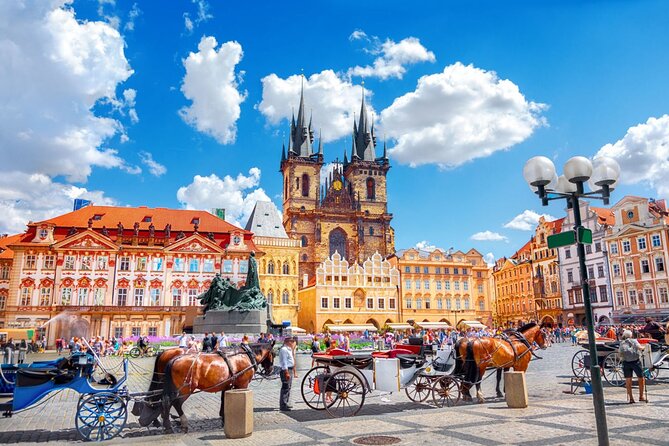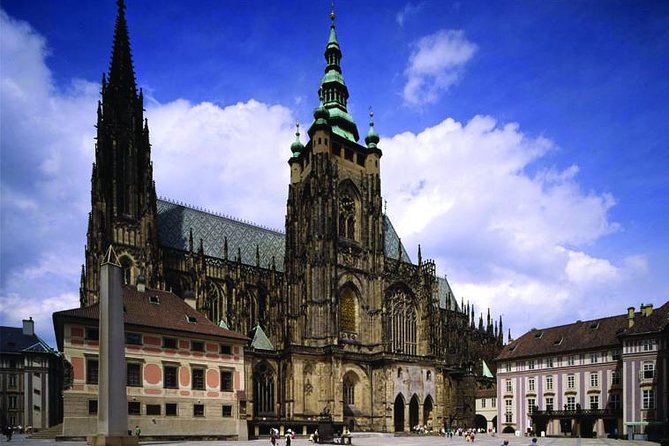Malá Strana (Czech for "Little Side (of the River)", German: Prager Kleinseite) or more formally Menší Město pražské (English: Lesser Town of Prague) is a district of the city of Prague, Czech Republic, and one of its most historic neighbourhoods. In the Middle Ages, it was a dominant center of the ethnic German (and since 16th century also Italian) citizens of Prague. It also housed many noble palaces while the right-bank towns were comparatively more bourgeois and more. The name Malá Strana translated into English literally means "Little Side", though it is frequently referred to as "Lesser Town", "Lesser Quarter", or "Lesser Side". This name derives from its position on the left (west) bank of the river Vltava, on the slopes just below the Prague Castle, in opposition to the larger towns of Prague on the right bank, to which it is conjoined by the Charles Bridge. The town was originally called the New Town beneath the Prague Castle (Czech: Nové Město pod Pražským hradem) after 1257 when it was founded. After Charles IV founded the New Town of Prague in 1348, the town was renamed the Lesser Town of Prague (Czech: Menší Město pražské). In the 17th century the unofficial name Little Quarter (Czech: Malá Strana) was first used. Malá Strana was founded by the King Ottokar II of Bohemia in 1257. As a royal town (a town founded by the king) it got many privileges. It was created by amalgamating a number of settlements beneath the Prague Castle into a single administrative unit. The original residents were expelled and mostly German craftsmen and merchants were invited by the king. Even though the city was royal, the king did not master the city as a whole. In the second half of the 14th century the Lesser Town of Prague was extended by the King and Holy Roman Emperor Charles IV who built a new defensive wall called Hunger Wall. In 1419-1420 the Lesser Town was burnt down by Hussites. In 1541 the town was strongly damaged again by a fire which killed fifty people. After this fire the town was rebuilt in the Renaissance style and many palaces of nobility were built there. The market place, now known as Malostranské náměstí (Lesser Town Square), was the center of the town. This square is divided into the upper and lower parts with the St. Nicholas Church in the middle. Baroque architecture predominates in Malá Strana, but the history of the district dates back to far before the Baroque era. Baroque architecture eventually dominated when the style was implanted on Malá Strana after the destructive fires in 1541. • The most extensive building of the Baroque Era on Malá Strana is the Wallenstein Palace. Albrecht von Wallenstein was a military general-in-chief of Emperor Ferdinand II. Under his order 26 new houses and old gates were built on the freed place. The extensive palace complex with five courtyards and the garden, which is set as a French Park. • The churches are the most frequent and interesting developments on Malá Strana. The finest one and the most prominent is the St. Nicholas Church. This is a masterpiece of Christoph and Kilian Ignaz Dientzenhofer, father and son. The finest painting in the church is an apotheosis of St. Nicholas, the defender of children, seamen, and wayfollowers. This painting is set in the dome. It depicts an apotheosis of Saint Trinity. • The famous statue of the Holy Infant Jesus of Prague is in the Church of Our Lady Victorious in Malá Strana. The devotion and the church drew millions of Roman Catholic faithful to Malá Strana throughout the years. • In 1989, the Prague Embassy of West Germany, in the Palais Lobkowicz, was the site of a drama involving thousands of East German refugees. Their cars were left behind in the quarter. • The famous Czech novelist Jan Neruda was born, lived in and wrote about Malá Strana; Nerudova Street is named after him. • The Petřín lookout tower is located in Malá Strana. • The Czech composer Bohuslav Martinu lived in an apartment near Kampa Island in the Malá Strana while a conservatory student, and a plaque now commemorates his stay.

Lesser Quarter (Mala Strana) Tours and Tickets
🎧 No audio guides are available in this language.
Malá Strana (Czech for "Little Side (of the River)", German: Prager Kleinseite) or more formally Menší Město pražské (English: Lesser Town of Prague) is a district of the city of Prague, Czech Republic, and one of its most historic neighbourhoods. In the Middle Ages, it was a dominant center of the ethnic German (and since 16th century also Italian) citizens of Prague. It also housed many noble palaces while the right-bank towns were comparatively more bourgeois and more. The name Malá Strana translated into English literally means "Little Side", though it is frequently referred to as "Lesser Town", "Lesser Quarter", or "Lesser Side". This name derives from its position on the left (west) bank of the river Vltava, on the slopes just below the Prague Castle, in opposition to the larger towns of Prague on the right bank, to which it is conjoined by the Charles Bridge. The town was originally called the New Town beneath the Prague Castle (Czech: Nové Město pod Pražským hradem) after 1257 when it was founded. After Charles IV founded the New Town of Prague in 1348, the town was renamed the Lesser Town of Prague (Czech: Menší Město pražské). In the 17th century the unofficial name Little Quarter (Czech: Malá Strana) was first used. Malá Strana was founded by the King Ottokar II of Bohemia in 1257. As a royal town (a town founded by the king) it got many privileges. It was created by amalgamating a number of settlements beneath the Prague Castle into a single administrative unit. The original residents were expelled and mostly German craftsmen and merchants were invited by the king. Even though the city was royal, the king did not master the city as a whole. In the second half of the 14th century the Lesser Town of Prague was extended by the King and Holy Roman Emperor Charles IV who built a new defensive wall called Hunger Wall. In 1419-1420 the Lesser Town was burnt down by Hussites. In 1541 the town was strongly damaged again by a fire which killed fifty people. After this fire the town was rebuilt in the Renaissance style and many palaces of nobility were built there. The market place, now known as Malostranské náměstí (Lesser Town Square), was the center of the town. This square is divided into the upper and lower parts with the St. Nicholas Church in the middle. Baroque architecture predominates in Malá Strana, but the history of the district dates back to far before the Baroque era. Baroque architecture eventually dominated when the style was implanted on Malá Strana after the destructive fires in 1541. • The most extensive building of the Baroque Era on Malá Strana is the Wallenstein Palace. Albrecht von Wallenstein was a military general-in-chief of Emperor Ferdinand II. Under his order 26 new houses and old gates were built on the freed place. The extensive palace complex with five courtyards and the garden, which is set as a French Park. • The churches are the most frequent and interesting developments on Malá Strana. The finest one and the most prominent is the St. Nicholas Church. This is a masterpiece of Christoph and Kilian Ignaz Dientzenhofer, father and son. The finest painting in the church is an apotheosis of St. Nicholas, the defender of children, seamen, and wayfollowers. This painting is set in the dome. It depicts an apotheosis of Saint Trinity. • The famous statue of the Holy Infant Jesus of Prague is in the Church of Our Lady Victorious in Malá Strana. The devotion and the church drew millions of Roman Catholic faithful to Malá Strana throughout the years. • In 1989, the Prague Embassy of West Germany, in the Palais Lobkowicz, was the site of a drama involving thousands of East German refugees. Their cars were left behind in the quarter. • The famous Czech novelist Jan Neruda was born, lived in and wrote about Malá Strana; Nerudova Street is named after him. • The Petřín lookout tower is located in Malá Strana. • The Czech composer Bohuslav Martinu lived in an apartment near Kampa Island in the Malá Strana while a conservatory student, and a plaque now commemorates his stay.
Overview
More Info
- The Kampa Island park along the river in Mala Strana was once filled with market gardens, watermills, and vineyards.
- Make time to see the John Lennon wall in Kampa, an unofficial graffiti tribute to the Beatles singer.
- The popular Franz Kafka Museum is located in Mala Strana on Cihelna Street.
- Keep an eye out for the carved and painted symbols found on various buildings—they were used to identify the owner of the house or what type of business operated there in the days before street numbers.
More Adventures for You
0$
0$
3000$

Likely to Sell Out
Price From
$83.26 USD
Perfect tour for all who want to discover the Prague’s most famous sights on a tour by foot, tram and boat! Start with a romantic stroll across the Charles Bridge, enjoy the panoramic tram ride to the Prague Castle, explore the mysterious Jewish Quarter and the medieval Old Town. Taste a traditional Czech dish and finally relax and admire the panorama of “the city of hundred spires“ on a river cruise with free refreshments. All this with a knowledgeable local guide!_en-US
Learn More
Price From
$42.18 USD
This informative and exciting tour runs through the most famous places in Prague and gives you a quick orientation of the city. In four hours you understand the general layout of the city centre, visit its most important monuments and learn about Prague's thrilling history. See the Charles Bridge, Lesser Town, the Prague Caste with St. Vitus Cathedral, Jewish Quarter and the Old Town of Prague - all this with a knowledgeable local guide!_en-US
Learn More

Price From
$59.95 USD
Enjoy this 3-hour cultural walking tour which takes you back in time while touring the Prague castle and its interiors._en-US
Learn More
Price From
1.00 USD
Perfect tour for all who want to discover the Prague’s most famous sights on a tour by foot, tram and boat! Start with a romantic stroll across the Charles Bridge, enjoy the panoramic tram ride to the Prague Castle, explore the mysterious Jewish Quarter and the medieval Old Town. Taste a traditional Czech dish and finally relax and admire the panorama of “the city of hundred spires“ on a river cruise with free refreshments. All this with a knowledgeable local guide!_en-US
Learn More

For Individuals with Hearing Loss
- Hearing kits
Access for Seniors
- Recommended time for visit 1 hour
- Recommended time for visit 2 hours
- Physical difficulty level - 4
Accessibility for wheels
- Special Parking
- Hilly area
- Accessible Toilet
Access for Visually Impaired
- Audio Guide
- Place has Special Guide Service
- Service animals permitted




